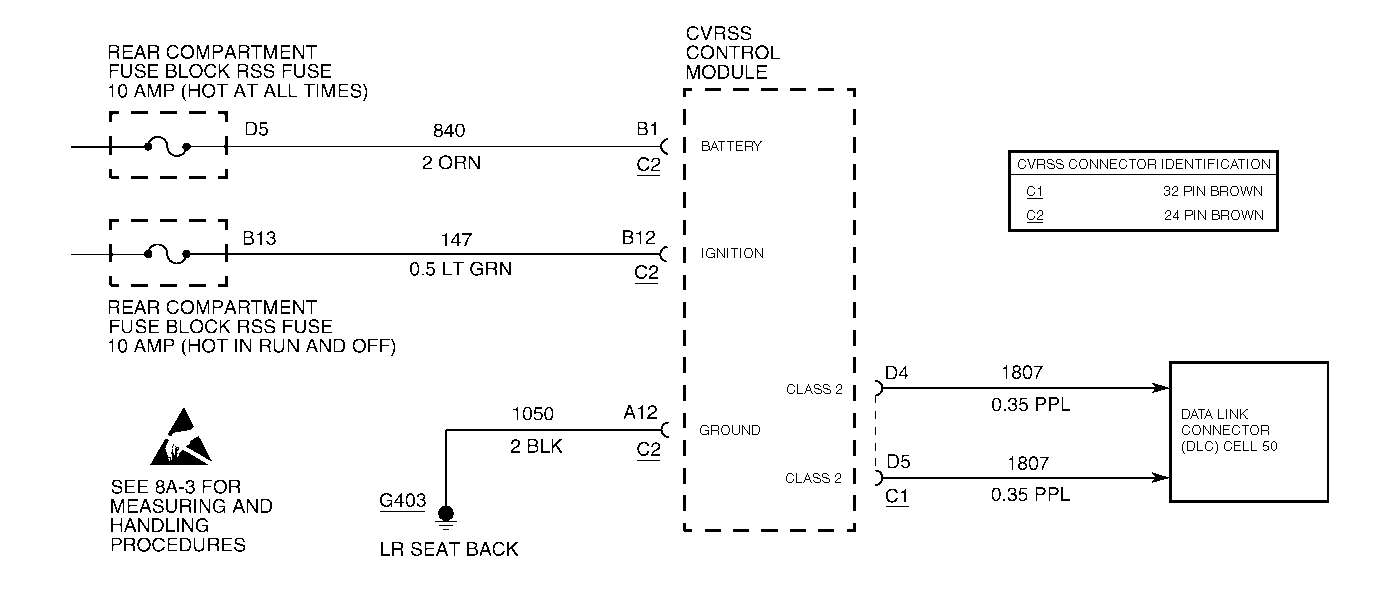
Circuit Description
The CVRSS control module communicates to the other electronic control modules on the vehicle via the CLASS 2 serial bus.
Conditions for Setting the DTC
The DTC is also set when the power to the CVRSS control module has been lost because of one or more of the following:
| • | loss of battery feed (loose terminals and/or fuses) |
| • | loss of ignition feed (loose terminals and/or fuses) |
| • | loss of a good CVRSS system ground |
| • | malfunction of the internal CVRSS control module. |
The DTC is also set when the CVRSS control module is powered and operational, but is unable to communicate with the IPC because of an open circuit condition, a short circuit to ground condition, or a short circuit to voltage condition on the CLASS 2 circuit.
The DTC turns HISTORY when the IPC can communicate with the CVRSS control module.
Action Taken When the DTC Sets
| • | The SERVICE RIDE CONTROL message will be displayed. |
| • | The vehicle speed may be limited, or the STABILITY REDUCED message will be displayed. |
| • | DTC P1611, U1056 and/or U1255 can be stored. |
Conditions for Clearing the MIL/DTC
| • | Use the scan tool. |
| • | Use the On-Board diagnostic CLEAR RSS CODES feature. |
Test Description
Important: Do not backprobe the sensors, actuators, or any sealed connectors.
The number(s) below refer to the step number(s) on the diagnostic table.
Important: DTCs P1611, U1056, and U1255 can also be a result of:
• Electrical problems with the wiring harness. • Intermittent breaks in Class 2 communication caused by other controllers
and/or wiring harness issues.
-
This step checks for a blown ignition fuse.
-
This step checks for blown battery fuse.
-
This step checks for an open circuit condition in the ground circuit.
-
This step checks for an open circuit condition in the battery circuit.
-
This step checks for an open circuit condition in the ignition circuit.
-
This step checks the CLASS 2 bus for a fault condition.
-
This step checks for a short circuit to ground condition in the ignition circuit.
-
This step checks for a short circuit to ground condition in the battery circuit.
Step | Action | Value(s) | Yes | No | ||||||
|---|---|---|---|---|---|---|---|---|---|---|
1 | Was the CVRSS System Check performed? | -- | Go to Step 2 | |||||||
Is the fuse blown? | -- | Go to Step 15 | Go to Step 3 | |||||||
Check the RSS 10 amp fuse D5 (HOT AT ALL TIMES) for a blown (open) circuit condition. RSS fuse D5 is located in the rear compartment fuse block. Is the fuse blown? | -- | Go to Step 17 | Go to Step 4 | |||||||
Check for an open circuit condition in circuit 1050. Important: Ground connection G403 should be torqued to 10 N·m. Is an open circuit condition present? | -- | Go to Step 5 | Go to Step 6 | |||||||
5 | Repair the open circuit condition in circuit 1050. Is the repair complete? | -- | -- | |||||||
Does the voltmeter display a voltage of 10 volts or more? | 10 volts + | Go to Step 8 | Go to Step 7 | |||||||
7 | Repair the open circuit condition in circuit 840. Is the repair complete? | -- | -- | |||||||
Measure the voltage between pin B12 of CVRSS control module connector C2 and ground. Does the voltmeter display a voltage of 10 volts or more? | 10 volts + | Go to Step 10 | Go to Step 9 | |||||||
9 | Repair the open circuit condition in circuit 147. Is the repair complete? | -- | -- | |||||||
|
Important: There are two 1807 circuits. Check circuit 1807 (at connector C1 terminal D4) for the following conditions:
Is a problem in circuit 1807 present? | -- | Go to Step 11 | Go to Step 12 | |||||||
11 | Repair circuit 1807. Is the repair complete? | -- | -- | |||||||
12 |
Important: There are two 1807 circuits. Check circuit 1807 (at connector C1 terminal D5) for the following conditions:
Is a problem in circuit 1807 present? | -- | Go to Step 13 | Go to Step 14 | ||||||
13 | Repair circuit 1870. Is the repair complete? | -- | ||||||||
14 | Is DTC P1611 set? | -- | Go to Step 21 | |||||||
Is a short circuit condition present? | -- | Go to Step 16 | Go to Step 19 | |||||||
16 | Repair the short circuit condition in circuit 147. Is the repair complete? | -- | Go to Step 20 | -- | ||||||
Is a short circuit condition present? | -- | Go to Step 18 | Go to Step 19 | |||||||
18 | Repair the short circuit condition in circuit 840. Is the repair complete? | -- | Go to Step 20 | -- | ||||||
19 | Check for an intermittent short circuit to ground condition in the affected circuit. Refer to Intermittents and Poor Connections . Is the check complete? | -- | Go to Step 21 | -- | ||||||
20 | Replace the appropriate fuse. Is the replacement complete? | -- | -- | |||||||
21 |
Important: Check for intermittent connections on fuses. Does the IPC display NO RSS DATA? | -- | Go to Step 22 | |||||||
22 |
Important: The CVRSS controller must be calibrated. Is the CVRSS control module calibrated? | -- | -- |
